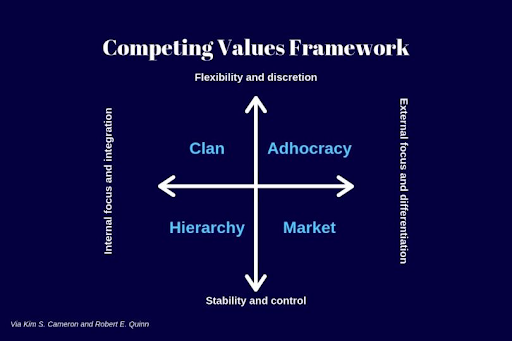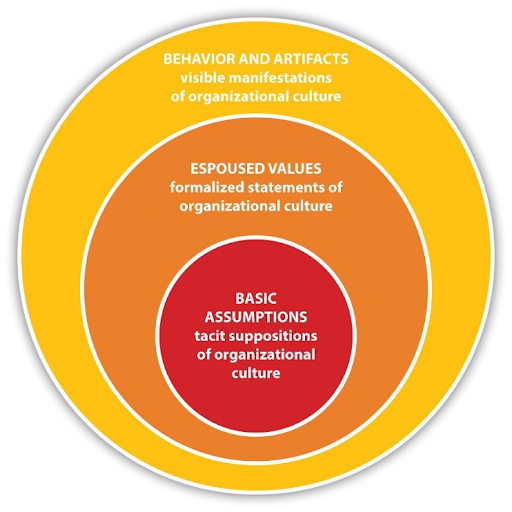Organizational Culture: Definition, Types, and How To Use It To Set The Tone
Many organizations and teams work hard to develop concrete strategies, goals, and action plans to advance an agenda. Still, many plans never move beyond the paper they are written on. Why?
It could be that the vision isn’t compelling enough, or communicated adequately to those who must buy in.
It could be that the organization or unit’s operational capacity to produce results simply isn’t there.
But what often gets overlooked is how the organizational culture may be parking new ideas.
Like the proverbial fish unaware of water, it can be easy to take for granted the way our environment shapes our behaviors and actions. Yet as soon as we’ve had a chance to experience a culture vastly different from our own, then we start to truly understand its impact.
Picture, for example, an American executive used to a self-motivated and casual way of working dropped into a corporate Japanese office for the first time. Suddenly, she has to navigate a completely new work setting where even greeting her colleagues in the hallway becomes a puzzle to decode. Now, can you imagine how that impacts her ability to collaborate and voice her opinions?
Recognizing the broader cultures of nationality may be easy, but every group to which we belong has its own set of rules and codes, whether they are intentional or not. These days more and more companies are realizing just how important it is to be intentional about cultivating a successful organizational culture that can boost performance and deliver top results.
In this article, we will take a closer look at:
- What exactly makes up organizational culture
- The different types that exist
- And how leaders can foster a positive culture of performance to propel their organization forward.
Why culture is important
Culture isn’t something that’s just nice to have. A report by business review and job website Glassdoor suggests that more than three-quarters of job seekers check out the company culture before applying for a role, while just over half say that culture is a more important factor in the decision making process than salary.
But culture isn’t only important for employee acquisition and retention – it’s also key to overall business performance.
For example, a report looking at Fortune’s 100 Best Companies to Work For – companies that have established a positive workplace culture – showed that these companies have higher average annual returns.
First things first, what is organizational culture?
Before we go any further, let’s define what we’re talking about when we say “organizational culture.”
Put simply, culture is group behavior individuals tolerate as normal and accepted. It is a shared frame of reference or way of doing things, and it is self-reinforcing.
Cultural norms demonstrate how a group of people deal with internal and external pressures, problems, and opportunities.
Over time, cultural boundaries emerge via:
- Beliefs: what is accepted as truth
- Mindsets: a set of accepted attitudes – the sum of your beliefs, opinions, and thoughts
- Behaviors: observable actions viewed as appropriate
New group members are taught that these beliefs, mindsets, and behaviors are the best way to deal with the environment, while peer pressure sets an invisible fence within which everyone is expected to operate.
We see it in how a group approaches work pace, punctuality, language, inclusiveness, candor, risk tolerance, attention to detail, dress codes, titles, achievement, gossip, hallway behavior, and more.
Culture gains strength as more people accept a behavior as normal.
This can be a positive or a negative, depending upon if the behavior advances the organization’s mission. Cultural reinforcement comes in many forms – a whispered comment or the cold shoulder or a meaningfully raised eyebrow that says “get back in line.”
Hardwired for culture

Biologically, people are hardwired first and foremost to stay safe.
Over thousands of years, we’ve learned that safety often means staying with the herd. And to stay with the herd, we learn to conform. We may even stay with herds we fundamentally don’t like just to survive and be accepted.
One study from the University of Leeds illustrates this fact, showing that a minority of 5% could easily influence the remaining 95% percent to follow their lead.
This brings us to how workplace culture exerts a potent effect on an organization. We spend a lot of time at work and it can be a fulfilling experience, evoking many positive emotions and relationships.
But when a culture is toxic or unhealthy, many people will not challenge it out of fear of being shunned from the group.
That’s why it’s important to harness the power of our herd instincts to ensure that the dominant culture is contributing to the organization’s goals and allows room for differing opinions and honest discourse.
Below, we take a look at some of the hallmarks of positive and negative organizational cultures.
Positive vs negative organizational culture
A positive organizational culture forms a strong base for success and elevates aspirations.
In a positive culture:
- People focus on priorities
- People produce efficiently and effectively
- Creativity is welcomed
- Shared accountability is the norm
- Opportunities exist for people to learn and hone skills
Conversely, a negative organizational culture can become a significant impediment to attaining goals and to successful organizational and personal evolution.
A negative culture:
- Stifles diversity and creativity
- No system exists for accountability
- Gossip is commonplace
- Lacks group cohesion
- Engenders frustration
Types of organizational cultures
Culture is unique to every organization, based on each organization’s vision, mission, and goals. But with that said, there are four widely accepted categories of organizational culture that a company can fall within.
These types, coined by researchers Robert E. Quinn and John Rohrbaugh in 1983, are centered around the idea that a company is defined by where it sits on a spectrum of flexibility vs stability and internal vs external focus.
Understanding these cultural types can help leaders evaluate the elements at play within their organizational culture – an essential step before anything can be adjusted or transformed.
Four types of organizational culture:
- Clan culture
Clan culture is defined by close-knit relationships and a family-like atmosphere. Employees are mentored and there is little hierarchy, encouraging a sense of collaboration and open communication.
This type of culture is very common within family businesses and start-ups. It values flexibility and has an internal focus. Clan cultures often result in pleasant working environments where employees feel recognized and respected, but they can also sometimes inhibit diversity and the ability to quickly respond to external market pressures. - Adhocracy culture
Ad hoc means “for this” or “for this situation” in Latin. As such, an adhocracy culture values on-the-fly innovations and employees that experiment and break boundaries. The goal is to keep the organization on the cutting edge and one step ahead of the competition.
Think: the Apples and Googles of the world. With great risk comes great reward, but this type of culture can also create stressful workplace competition and lead to some big downfalls if things don’t pan out as expected. - Market culture
As you might expect, the market is the driver of this organizational culture. Companies that adopt this culture set high standards and are driven by metrics and results. There are often hard rules that encourage employees to deliver on goals and contribute to the bottom line.
This culture can often be found among industry leaders and exemplifies an approach with a high external orientation and degree of control. It can lead to great results, but the lack of flexibility and personal focus can also easily create a toxic culture of burnout. - Hierarchy culture
This is what you’d picture when you think of a classic corporate culture. Structure and control are valued above all else, with roles and tiers clearly defined. This culture is risk-averse and operates with a top-down style of management, where orders are passed down a distinct chain of command.
These organizations tend to be very stable, which can lead to consistent results. However, this environment is generally not ideal for stimulating creativity and innovation.
To dive deeper into each of these organizational culture types, read on here
Drivers – Edgar Schien’s three levels of organizational culture
Now that we have an understanding of several common ways culture manifests within an organization, let’s gain a better understanding of the factors that drive and shape it.
In the 1980s, Edgar Schien, a professor at the MIT Sloan School of Management, famously developed a model of organizational culture that still holds clout today.
His model posited that organizational culture is expressed and influenced on three levels:
- Artifacts
These are the most obvious features of an organization. The elements that are tangible and easy to identify, from the design of an office space to brand colors to employee dress code.
You can think of these as the tip of the iceberg. They give you an idea of what a company stands for and what the culture is like, but more investigation is needed to uncover what is really driving the organization below the surface. - Espoused values
The next level of culture are a company’s expressed values.These are evident in company vision and mission statements, employee contracts, and any stated philosophies of the organization. They are also seen in the behaviors and relationships of employees within the organization and in how employees conduct themselves with people outside of the organization.
Espoused values are a deeper indicator of company culture, but they are not the end-all be-all, especially if the values are not in line with the underlying assumptions of an organization. - Underlying beliefs and assumptions
The most essential level of organizational culture are the implicit beliefs and assumptions that direct the actions of people within the company. These beliefs are often unconscious but they are the strings that truly control how people act and operate.
Underlying assumptions can sometimes be hard to pinpoint, especially when they are not in alignment with a company’s espoused values. For example, a company might say that one of their core values is ensuring a healthy work-life balance for employees, but then employees are encouraged to stay late to show that they are “putting in the time.” Getting at these underlying beliefs is critical if you want to truly understand and change an organizational culture.
Schien says that a successful organizational culture occurs when these three layers are in agreement. Only then, can a culture “walk the talk” and experience a sense of unity and cohesion.
The role of subcultures
Defining an organization’s culture can be complicated because it’s often a combination of subcultures. As soon as an organization begins to grow, it’s common for subcultures to arise.
Subcultures are smaller groupings of individuals who share beliefs, mindsets, or behaviors within the larger culture. These subgroups can be based on department, region, or hierarchy, among other things.
While at first, the idea of subcultures may seem alarming, they are perfectly natural and can actually enhance an organization by making it more agile and open to new ideas. That is, as long as the subculture still shares the same core beliefs as the larger organizational culture.
Only when subcultures run counter to the beliefs and values of the overarching organizational culture should they be viewed with concern and addressed.
How to develop a culture of positive performance

Let’s go back to our original premise. Say your organization has worked hard to develop concrete strategies, goals, and action plans, but your plans are not going anywhere.
If that’s the case, it might be time to ask some key cultural questions.
Are the people who make up the organization – at all position levels – demonstrating a desire to deliver results toward the vision or target?
Do most people know what they need to do, why they need to do it, and have the tools to do it?
If you answered yes to those questions and your goals are still not being reached, look to the culture.
A successful culture is aligned with a company’s purpose, values, and brand.
But for many organizations, there is a large disconnect between these things and the actual culture at play.
Gallup found that only 41% of employees across all sectors strongly agree that they know what their company stands for and what makes it different from competitors.
When employees don’t know what their company stands for, it’s difficult for them to find meaning and purpose in their work. And without purpose and meaning, how can they become champions of a positive culture?
The role of leadership
Research professor, author, and speaker Brené Brown says, “A courageous culture connects its values to specific behaviors so people know what is expected, encouraged, and rewarded within their team and organization.”
This starts and ends with leadership. Leaders set the tone – organizational culture is ultimately a reflection of the behaviors and attitudes leaders exemplify in themselves and tolerate in their relationships.
Research shows that managers – and we know that great managers act as leaders – account for 70% of the variance in team engagement, and for managers to positively influence employee wellbeing, they must act as a coach so that they can have meaningful conversations with their team members.
As a leader, there is no one silver bullet for developing a positive culture. Every team comes with its own set of strengths and weaknesses, but there are several practices you can implement to secure the best culture for your group.
- Personally champion the desired change
Bravely role model core values and positive behaviors.
Every single person in the organization has a platform for change. Every single person in the organization is the leader that someone else looks to for guidance.
The platform held by executives and middle managers can attract a larger spotlight, so it’s important to use that platform appropriately. Be visible in your commitment to a productive work environment. Walk around, touch base with people, and exemplify how a positive culture behaves. - Demonstrate serious resolve with bold action
Any major change to a culture will need to be backed up by serious actions. Be overtly obvious that the culture must change and the old norms will no longer be tolerated.
Make one or two bold moves to disrupt the current cultural norm – whether that looks like instating a new employee review process or changing the script for how to approach new clients. Then choose an enthusiastic group of early adopters to implement those bold moves. Reinforce your actions by shifting rewards and continuing to roll out more positive changes. Hold true to your word and don’t change course when others test your resolve. - Sell, sell, sell the expected new norms
Expend whatever energy is needed to move the cultural needle. Remember, the culture has a huge impact on performance, so this is not a sidebar issue. Communication plays a major role in setting new norms and people are hungry for the truth, so focus on putting honest, timely information into the work world, and avoid sugar-coating reality.
It’s also important to avoid communication voids. Otherwise, the rumor mill will become the default messenger. Make sure your team is clear on the what, why, and how so that you can remove the temptation to gossip. - Honor positive cultural traits and champions
Recognize the departments and groups of people who model the positive culture the organization seeks. Examine the conditions that helped the positive culture flourish in these groups – learn why they resonated and build from there. Reward these groups by easing off micro-management and permitting greater flexibility in how they do their jobs. - Be purpose-driven
As we mentioned before, purpose is key to cultivating a positive culture because people want to be part of a valuable mission. Ensure they know how important their job and performance is to achieving outcomes by showing each person how their work leads to the larger win. Make problem-solving fulfilling and explain how a toxic culture impedes the shared purpose. - Score some quick, small wins
Next to the bold moves, also consider launching some ideas that can be executed quickly. Hold lunch talks, optional book clubs, pay-it-forward concepts, greeters, free coffee/tea stations, etc. Anything that sparks a smile or a good thought in an employee’s daily routine and is aligned with the culture you want to create. - Switch up your viewpoint
As a leader, it’s always critical to take the perspectives of others into consideration and consider the situation from different positions. Understand that what’s upsetting you about the current culture may look completely different from another perspective or with a long-range lens.
Consider if you are shutting people down by how you act, particularly under stress.
Are you listening?
Are you seeking proposals and input from others?
Are you using the power of asking questions to garner insights?
Leaders who don’t listen often wind up with teams that don’t talk, and this silence can take a toll on organizations and people. - Don’t tolerate “villain stories”
A villain story occurs when we don’t know the motives or all the facts about someone in a situation, so we make up a story – filling gaps with something that sounds plausible. Usually the main character winds up looking like a bit of an ogre. Those who tell villain stories are actively destroying the reputations of others.
As a leader, it’s important to nip these kinds of actions in the bud when you see them occurring. Stay composed, but steadfastly show no tolerance for vilifying others. - Provide timely, constructive, and positive feedback
Leaders must be teachers who notice the need for improvement and encouragement. One of the worst things for people is to receive no performance feedback, which sends a message that their work doesn’t matter one way or the other.
On the flip side, research shows that when employees do receive feedback, 85% take more initiative in the workplace. Harness the power of the proverbial “pat on the back” or congratulatory handshake and recognize accomplishments. Give specific direction, praise, or thanks to show you are paying attention to the actions and contributions of your team members. - Direct training efforts to lift the culture
All training efforts – every single course, webinar, session – should support positive cultural mindsets and actions. By promoting continuous learning and investing in new skill development, you have a chance to signal and further instill your company values and purpose. Tune content, formats, trainers, and how participants are selected accordingly.
Changing organizational culture – embracing questions and feedback to guide transformation

As we discussed above, culture is self-reinforcing by nature. This means that changing culture must start with the self.
Malcolm Gladwell’s best-selling book The Tipping Point teaches that changing culture requires a small number of people in a small number of situations to start behaving very differently – and that behavior spreads to other people in similar situations.
Leaders within a work team have a responsibility to help establish and own the conditions of their environment, and a big part of that comes down to asking the right questions and giving team members the necessary feedback to create change and the desired positive behaviors.
Feedback allows us to:
- Gain clarity
- Learn
- Improve the quality of work / effort
- Strengthen interpersonal relationships
To be helpful, course-correcting conversations or expressions of praise or appreciation need to be timely and tailored to how the recipient can best receive the comments.
Questions are an important part of giving and determining feedback.
Asking and encouraging questions shows that a leader embraces creativity. The simple act of asking a question creates opportunities for others to feel comfortable asking questions too.
Among a myriad of other things, this back-and-forth method of inquiry:
- Builds relationships by demonstrating that an individual’s perspective matters
- Uncovers fresh perspectives, challenge assumptions, and advances critical thinking
- Promotes clarity by making it okay to double-check meaning and detail
- Encourages people to bring proposals to the table
Consider how different it is to say, “I think this is what we’ll do.” versus “What do you think about doing this idea?”
The flow and energy of the conversation changes because the brain listens differently to a question-and-answer exchange versus a straight lecture. It’s a higher level of mental agility.
The ultimate buy-in for the decision is probably also stronger because when people answer questions, what is voiced leads to an idea or proposal that is their idea – not an order from the leader.
Here are a few powerful questions that should be in every leader’s toolbox:
- What if?
- What do you see that I don’t?
- What needs to be done from your perspective?
- Why this idea?
- What else?
- How do you think this plays out?
- What makes this hard?
- What can I do to help?
Conclusion
Ultimately, an organization is just a group of people united by a common mission. The culture developed by that group of people makes a big difference in mission performance and each employee’s personal workplace experience.
While culture can come in many different shapes and varieties, leaders must take the lead on ensuring that appropriate mindsets and behaviors become the norm for their teams, staying curious and open to questions along the way.



.png?width=600&name=The%20Ultimate%20Guide%20to%20Adapting%20Your%20Sales%20Process%20to%20Incorporate%20Remote%20Sales%20and%20Energise%20Your%20Team%20to%20Boost%20Results%20(1).png)